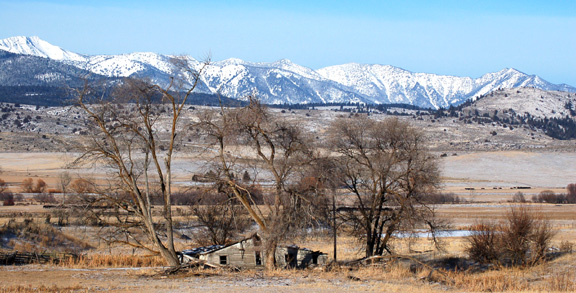- ODFW Documents 10 Wolves East of Joseph, OR (Video)
- Grazing concerns fueling debate over Ore. land transfer
- More Environmental News
______________________
ODFW Documents Oregon Wolf Population Expansion
Back in early September I had called Russ Morgan, ODFW Wolf Coordinator to inquire about why the fladry and other non-lethal protective measures had been removed from the Jacobs Ranch just a few months prior to the final predation by, and killing of, our only documented Baker County wolves. He indicated that wolves might become accustomed to the fladry and sound devices if they were to remain there permanently and that wolves seemed to be staying away from the ranch area for a long time.
At the time he assured me that there were at least two wolf packs in Oregon, in the Wenaha Wilderness area and the Imnaha area. He also felt they would likely spread into the upper Grande Ronde watershed north and west of Anthony lakes at some time in the future. Today, ODFW released the following information which indicates the Imnaha pack is doing quite well.
.jpg) Alpha Male of Imnaha Pack-ODFW Photo
Alpha Male of Imnaha Pack-ODFW PhotoFrom ODFW:
MEDIA ADVISORY
Oregon Department of Fish and Wildlife
Contact: Michelle Dennehy (503) 947-6022
Fax: (503) 947-6009
Internet: www.dfw.state.or.us
Nov. 19, 2009
Video shows10 wolves in the Imnaha pack
A video taken by ODFW on Nov. 12, 2009 in the Imnaha Wildlife Management Unit (east of Joseph, Ore. in Wallowa County) shows at least 10 wolves make up a pack that ODFW has been monitoring since June 2008. The video was taken from an adjacent ridge across a canyon and shows a mixture of gray and black individual wolves moving upslope.
VIDEO HERE:
http://www.dfw.state.or.us/news/video_gallery/imnaha_wolf_pack.asp
Also found here:
http://www.youtube.com/user/IEODFW
http://www.youtube.com/watch?v=kqtMLxzSMok
“ODFW has been regularly monitoring this pack but until this video was taken, we only had evidence of a minimum of three adults and three pups making up the pack, says Russ Morgan, ODFW wolf coordinator. “Pups can be difficult to distinguish at this distance, but it appears there may be as many as six pups in the video.
Wolf litters generally average around five pups, but more is not uncommon,” he added.
The alpha female of the pack is B-300, a wolf first observed in Oregon in January 2008. Her radio collar stopped working in Fall 2008 but ODFW re-collared her in July 2009 and wildlife managers continue to track her and other members of the pack.
ODFW will continue to monitor this pack and another pack in the Wenaha Unit (Wallowa County) to count their pups during the month of December. For a pack to be defined as a “breeding pair” (an important step in wolf conservation) it must produce at least two pups that survive to December 31 of the year of their birth.
Under Oregon’s Wolf Conservation and Management Plan, the Fish and Wildlife Commission will consider delisting wolves from the Oregon Endangered Species List when four breeding pairs for three consecutive years have been documented in eastern Oregon.
The video is more evidence that wolves are establishing themselves in northeast Oregon.
Wolves throughout Oregon are protected by the State Endangered Species Act., They are also protected by the Federal Endangered Species Act west of Highways 398/78/95.
Photos of B-300 and alpha male in Imnaha wolf pack:
http://www.dfw.state.or.us/news/images/photo_gallery/wolves_in_the_news/content/confirmedwolf_large.html
http://www.dfw.state.or.us/news/images/photo_gallery/wolves_in_the_news/content/B300July2009_large.html
http://www.dfw.state.or.us/news/images/photo_gallery/wolves_in_the_news/content/Imnaha_Alpha_Male_Aug2009a_large.html
http://www.dfw.state.or.us/news/images/photo_gallery/wolves_in_the_news/content/Imnaha_Alpha_Male_Aug2009b_large.html
ODFW Wolves Slide Show:
http://www.dfw.state.or.us/news/images/photo_gallery/wolves_in_the_news/content/BakerdepredationApril2009_large.html

Gray Wolf (Canis lupis) [USF&WS Photo]
More BakerCountyBlogs on Wolves:
http://bakercountyblog.blogspot.com/2009/05/poppycock-proclamation.html
http://bakercountyblog.blogspot.com/2009/05/this-is-re-post-of-blog-from-december-6.html
Oregon Wolves
http://www.rangebiome.org/editorials/oregonwolves.html
___________________________________
This story came to me from RangeNet.org at Yahoo Groups (http://www.rangenet.org/).
----- Original Message -----
From:
Sent: Thursday, November 19, 2009 2:38 PM
Subject: Land Letter: Grazing concerns fueling debate over Ore. land transfer
Grazing concerns fueling debate over Ore. land transfer (11/19/2009)
Scott Streater, E&E reporter
A proposal to transfer thousands of acres of national forest in southern Oregon to the National Park Service has renewed debate over whether the Forest Service should control some of the nation's most environmentally sensitive lands.
The controversy stems from a bill sponsored by two of Oregon's senior Democratic lawmakers, Sen. Ron Wyden and Rep. Peter DeFazio, that would transfer 4,070 acres from the Rogue River-Siskiyou National Forest to the adjacent Oregon Caves National Monument, managed by the Park Service.
The lawmakers argue the Park Service is better equipped to maintain forest trails and campgrounds, and that the Forest Service has failed to protect the land from the effects of grazing, including the polluting of the monument's drinking water source with livestock manure.
But the "Oregon Caves National Monument Boundary Act" highlights much bigger problems for the Forest Service, including years of steep budget cuts and the redistribution of tens of millions of dollars from national forest upkeep and maintenance programs to firefighting accounts.
The bill also points to ongoing concerns about the Forest Service's multiuse mission, which holds that the agency must manage its holdings for timber harvesting, energy development, grazing and recreational activities while also implementing sound conservation practices across 191 million acres of public land.
"I think it's both a budget issue and a question of whether a multiuse agency can effectively manage these fragile natural sources," said Ron Tipton, senior vice president for policy at the National Parks Conservation Association, or NPCA. "The Forest Service does it well in a few places, but not in many."
Joseph Walsh, a spokesman at the Forest Service's headquarters in Washington, D.C., declined to comment on the legislation or the issues behind it. Rogue River-Siskiyou National Forest supervisor, Scott Conroy, also declined comment, saying it was inappropriate to discuss "pending legislation."
Following Washington's lead
But the Oregon Caves National Monument proposal is not the first time Congress has sought to transfer national forest land to the Park Service.
Lawmakers from neighboring Washington have sought to transfer management of the Mount St. Helens National Volcanic Monument, deep within the 1.3-million-acre Gifford Pinchot National Forest, from the Forest Service to the Park Service, in part to provide the monument with direct appropriations from Congress and end the Forest Service's practice of raiding its budget to meet other priorities (Land Letter, March 26).
But the Forest Service, an agency of the Agriculture Department, has shown no willingness to cede its land holdings in either state to another agency and department.
In testimony this week before a House subcommittee, Forest Service officials resisted ceding control of the Rogue River-Siskiyou acreage, arguing instead for more time to develop a cooperative monument management plan with the Park Service.
"We believe inter-agency cooperation would carry out the purpose of the bill to enhance the protection of the resources associated with the monument and increase public recreation opportunities through a joint public involvement and review process, to ensure that public concerns and desires are addressed," said Lenise Lago, deputy regional forester for the Forest Service's Pacific Northwest region.
Steve Whitesell, NPS associate director for park planning, facilities and lands, testified at the same hearing that it could cost the agency as much as $750,000 a year to manage and maintain the additional 4,070 acres.
But issues of sufficient funding and preserving sensitive lands, while central to the Forest Service's land management mandates, cannot be solved by any inter-agency agreement, said Sean Smith, policy director for the NPCA's northwest regional office in Seattle.
"We're supporting this transfer proposal because we believe it's better for the resources, recreational opportunities and the regional economy," Smith said. "The benefits would outweigh any of the costs."
Saving a cave stream
From near the peak of Mount Elijah in the Siskiyou mountain range, Cave Creek flows downhill through the Rogue River-Siskiyou National Forest and into the Oregon Caves National Monument before eventually emptying into the Pacific Ocean.
Along the way, Cave Creek provides drinking water for monument visitors, but officials say that is not at the core of the debate over which agency should manage the river and its broader watershed.
Rather, the 4,000-acre section of national forest is supposed to act as a kind of buffer zone for the creek as it emerges from the mountains and winds its way toward the cave. But Park Service officials say pollution from cattle grazing on the national forest property threatens to erode water quality in the monument.
To the chagrin of Park Service officials, the Forest Service granted permission to a local rancher to graze hundreds of head of cattle in the Cave Creek watershed. In exchange for the grazing allotment, the rancher is supposed to erect fences and other physical barriers to keep the cattle out of the monument property and far away from from where the creek enters the caves.
"But the Forest Service has never gotten the rancher to implement that part of the agreement," said Vicki Snitzler, the monument superintendent in Cave Junction, Ore.
That raises the possibility of cow manure, dirt and other polluted runoff being deposited into the creek. By transferring the 4,000 acres to the Park Service, the government could buy back the grazing allotment, estimated to be worth about $200,000.
"The main purpose of the expansion [legislation] is to draw a boundary around the watershed, to protect water in the cave as well as the drinking water for monument visitors," said Snitzler. In fact, the general management plan for the Oregon Caves National Monument, finalized in 2000, includes a stipulation that the Cave Creek land be transferred from the Forest Service to the Park Service.
"We don't see that rancher as a bad guy at all. But in order to protect the stream, they need to put an end of grazing," said Smith, the NPCA's regional director.
Extending NPS's reach
Shifting control of the Rogue River-Siskiyou National Forest property to the National Park Service also would support the findings of a recent sweeping study that recommended expanding the national park system.
The report, entitled "Advancing the National Park Idea," was commissioned by the NPCA and written by a panel of distinguished luminaries, including former U.S. Sen. Howard Baker Jr., and retired Supreme Court Justice Sandra Day O'Connor.
Among other things, the report notes that the Interior Department's failure to expand the 84-million-acre park system has fostered conditions whereby "familiar open landscapes are disappearing before the relentless advance of suburban sprawl and big-box commerce" (Land Letter, Sept. 24).
"There's a growing sense that the NPS is not complete and that some of the areas that belong in the national park system are currently managed by either the Forest Service or the BLM," said Tipton, the NPCA policy director.
Scott Streater writes from Colorado Springs, Colo.
__________________________
MORE EVVIRONMENTAL NEWS
--------------------
Should private cattle graze on public lands?
A lawsuit has been filed to protect John Day River fish, but ranchers say they are dependent on that federal land
By Lauren Dake / The Bulletin
http://www.bendbulletin.com/apps/pbcs.dll/article?AID=/20091119/NEWS0107/911190424/-1/rss
Published: November 19. 2009 4:00AM PST
MADRAS — It's a battle that has ranchers pitted against environmentalists. An ongoing legal dispute over grazing practices in the Malheur National Forest has many Eastern Oregon ranchers worried about their livelihoods and the future of their ranches. Environmentalists are concerned grazing on certain parts of the public forest is degrading habitat for threatened fish.
On Wednesday, ranchers from Central Oregon showed their support for their eastern counterparts at the Central Oregon Livestock Auction yard in Madras.
One-by-one, as cattle entered the auction floor, their weight was registered and the announcer started the bidding.
But once the animal was sold, the buyer immediately signaled he was returning the animal.
And so, the bidding started again on the same animal. It was an effort to raise money for the nearly $450,000 in legal fees the group known as Five Rivers Grazing Defense has incurred while trying to hold on to grazing permits on forestland.
Approximately 80 animals were donated for the fundraiser, which collected about $46,000 for the group.
The auction, which included the sale of other cattle, not just those in the fundraiser, started at 9 a.m. and was scheduled to last until about 10 p.m.
Land use lawsuit
The dispute was sparked by a lawsuit filed by the Bend-based Oregon Natural Desert Association against the U.S. Forest Service. ONDA would like to see the Forest Service remove grazing in certain areas along Forest Service land along the John Day River, an area important for steelhead habitat.
The ranchers found out the only way to have a voice in the debate was to file a lawsuit. So, they are also suing the Forest Service, whose representatives did not return calls for comment.
Steelhead are listed as threatened under the federal Endangered Species Act.
Brent Fenty, the executive director of ONDA, said grazing ruins riparian areas, kills cover that shades streams and keeps the water temperatures low, which fish need to survive.
“For us, it's straightforward,” Fenty said. “Our expectation in the short term is we want the U.S. Forest Service, charged with managing grazing, to comply with their own laws and regulations to protect stream health and native fish. In the long term, we hope to protect the most important areas of fish habitat.”
Fenty was quick to point out that he doesn't believe this is a precedent-setting lawsuit.
“I've heard other folks say this is a huge precedent for throughout the West,” he said. “This lawsuit hinges on specific data collected on the ground about conditions on specific allotments. And the Forest Service wasn't enforcing their own rules and regulations. It's less a question of public lands grazing across the West and more specific conditions on these allotments and whether the Forest Service is enforcing (management) to allow threatened steelhead and bulltrout populations to recover.”
Ranchers worry
But Trent Stewart, co-owner of the Central Oregon Livestock Auction in Madras, disagreed with Fenty.
That's why he agreed to host the fundraiser and donate all proceeds to the Five Rivers Grazing Defense fund. He said Central Oregon ranchers are also dependent on public lands, such as in the Ochoco National Forest, for survival.
“If they get started, it's not just going to happen there. Here in the West, we're dependent on public ground for grazing,” he said.
Jack and Katie Johns' Fox Valley ranch has been in their family for more than 100 years. They depend on the grass in the Malheur National Forest every year to feed their cattle. Without it, they would have to cut their cattle operation in half, and they worry about what would happen in the future to their family ranch.
Ken Holliday is another Five Rivers Grazing Defense rancher in Grant County.
“This isn't just going after grazing permits,” he said. “This is going after our ranches. ... It's not just public grazing but our livelihood. It's going after the next generations, our kids, our son. If (we lose), it's a done deal.”
Holliday said he believes ranchers are good stewards of the land and it's in their benefit to do so.
Historically, grazing has been used as a tool to manage forestland, he said. It helps prevent forest fires and helps create habitat for wildlife.
Federal study
Fenty doesn't disagree the lawsuit could make management tougher for ranchers.
“It goes back to this underlying question of what is the primary and best use of our public lands,” he said. “And I think for well over a century, grazing has been the priority use for public lands in the West. And I think changing social values recognizing preserving and restoring healthy fish populations is something we value our public lands for. ... I would hate to ... presume that just because it's historically been a priority, we assume it's a priority use in the future.”
Fenty said the National Marine Fisheries Service found steelhead populations in the middle, south and upper forks of the John Day were not viable and identified grazing as degrading the water quality.
The ranchers pointed to the large horse and elk populations and say they are responsible for trampling the area more than domestic cattle.
Elizabeth Howard, the Portland-based lawyer representing the ranchers, said the methodology used by the National Marine Fisheries Service to measure bank damage is erroneous.
“They go out and look for hoof prints along a certain area of stream,” she said.
“The problem is there is no correlation of hoof prints along the stream and impact to steelhead. ... They have never connected the dots,” she said.
Lauren Dake can be reached at 541-419-8074 or at ldake@bendbulletin.com.
---------------------
Western Watersheds Project
Online Messenger #163
Idaho Land Board Finally Throws in the Towel
~ Jon Marvel
http://hosted.verticalresponse.com/435877/95adb30417/1454001502/2094f66e48/
Western Watersheds Project was created in 1993 to bid for expiring grazing leases on Idaho State School Endowment Lands. The legal fight for this seemingly simple desire for open competition as required by the Idaho State Constitution has taken over 15 years, but finally, it now appears to be over.
With the legal settlement described in the Associated Press story included below, the State of Idaho has thrown in the towel and accepted conservation leasing as well as fair and open competition for expiring grazing leases.
The final blow to the Land Board was their legal liability under the Ku Klux Klan Act of 1871 Section 1983 that prohibits government agents from denying citizens their civil rights and equal protection under the law.
WWP is grateful to Lazy Y Ranch and their attorney Laird Lucas for bringing this successful civil rights litigation that ensures fairness for citizens and a fair return for the school children of Idaho !>
Here’s the AP story:
Idaho to pay $50K to settle grazing lease lawsuit
By John Miller, Associated Press
11/17/09
BOISE, Idaho — Idaho agreed Tuesday to pay $50,000 and pledged to follow anti-discrimination rules to settle a federal lawsuit against state officials who awarded grazing leases to ranchers, not the environmentalist who had offered more money.
The Idaho Board of Land has also committed to revising its rules to allow conservation groups to lease state endowment trust lands, a big change after years of fierce litigation. The board's five members are the governor, state controller, secretary of state, attorney general and superintendent of public instruction.
In 2006, Washington state businessman and environmentalist Gordon Younger was the high bidder on seven Idaho grazing leases, but lost when the Board of Land with then-Gov. Jim Risch gave the leases to livestock owners. Younger, who planned to manage the lands to restore what he called "their degraded streams and wildlife habitats," sued in U.S. District Court on grounds he was the victim of discrimination.
Laird Lucas, attorney for Younger's Lazy Y Ranch Ltd., said Tuesday he's optimistic this settlement and the Board of Land's revised leasing rules represent a departure from the past, when conservation groups were bullied out of winning state grazing leases and left no other option than to sue.
"If someone is willing to put up money for conservation on state lands, we want them to be treated fairly," Lucas said. "This is the first time we've achieved reform in how state lands are managed."
The state's new leasing rules, whose changes address more issues than just this lease dispute, await final approval in the 2010 Legislature.
There, they could still face opposition from livestock-industry advocates.
If the rules are rejected, Tuesday's settlement allows Younger to refile his claims against Idaho.
But "if legislative ratification does occur, Lazy Y waives, forfeits and otherwise relinquishes any and all right to refile such claims," according to the pact, which also requires Board of Land members to "recognize their obligation to apply applicable statutes and rules consistent with federal or state equal protection requirements."
The Idaho Constitution demands Board of Land members carefully preserve state endowment trust lands, to secure the maximum long-term financial return to benefit public schools.
Ranchers have contended their industry's impact on local economies should also be taken into account, but that argument has failed to persuade judges: Western Watersheds Project, an environmental group to which Younger is a contributor, in 1999 won unanimous Idaho Supreme Court decisions rejecting grazing-lease preferences for ranchers.
Clive Strong, a deputy attorney general and natural resource law specialist, said Idaho's new leasing rules will help create a level playing field for all parties interested in securing a lease - and help the state avoid costly lawsuits.
"The Land Board recognized the current process was not working and was leading the way to litigation," Strong said. "It was determined to find a better process."
According to Tuesday's settlement, state officials didn't acknowledge wrongdoing, but will pay $50,000 to cover the Lazy Y's litigation fees. Lazy Y, meanwhile, held open the possibility of bidding for the 10-year leases again when they become available.
Jon Hanian, a spokesman for Gov. C.L. "Butch" Otter, and David Hensley, Otter's staff lawyer, didn't immediately return phone calls seeking comment.
~~~~~~~
Of the many sections of the Ku Klux Klan Act, the most influential today is the little debated section 1983. The section provides in part:
Every person who, under color of any statute, ordinance, regulation, custom, or usage, of any State or Territory or the District of Columbia, subjects, or causes to be subjected, any citizen of the United States or other person within the jurisdiction thereof to the deprivation of any rights, privileges, or immunities secured by the Constitution and laws, shall be liable to the party injured in an action at law, suit in equity, or other proper proceeding for redress....
The language of the statute is much the same as it was in 1871. Interestingly, the 1874 revisions resulted in the apparently inadvertent insertion of the words "and laws," which has resulted in a large expansion of the statute's coverage. Reference to the District of Columbia and to territories was added in 1979.
Section 1983 allows people to sue for state and local violations of the Constitution and federal law. It enables private citizens to affirmatively enforce these rights. Lawsuits may be brought in federal or state court, and the remedies available for violations include damages and injunctive relief. A key to Section 1983's revitalization was when the Supreme Court breathed new life into the Fourteenth Amendment. The Court developed an extensive theoretical framework for the due process and equal protection clauses, under which it recognized a wide variety of federally protected rights. Also, in Monroe v. Pape (1961), the Supreme Court interpreted Section 1983's "under color of law" requirement to cover cases in which state and local officials were not acting in accordance with state law but in violation of it. This was the beginning of a series of interpretations that loosened the judicial stranglehold on civil rights legislation that had been passed during the Reconstruction era.
----------------
Center For Biological Diversity
Endangered Earth Online
No. 487, November 19, 2009
http://salsa.democracyinaction.org/o/2167/t/9524/blastContent.jsp?email_blast_KEY=1161205
Suit Kills Wolf-killing Policy
Three California Species Win Habitat Protection
Suit Challenges Grand Canyon Uranium Mining
Rare Green Sturgeon Earns Recovery Roadmap
Center: Las Vegas Fouling Its Own Drinking Water
Flying Squirrel vs. Bush: 54th Suit Filed Against W's Horrid Legacy
Utah Lead-bullet Ban Gaining Steam, Help Save the Condor Today
The Rebirth of Environmentalism: New Book Examines Rise of Center for Biological Diversity
Center Polar Bear Ads Ranked 10th in Nation
U.N.: Free Condoms to Combat Climate Change
http://salsa.democracyinaction.org/o/2167/t/9524/blastContent.jsp?email_blast_KEY=1161205












No comments:
Post a Comment